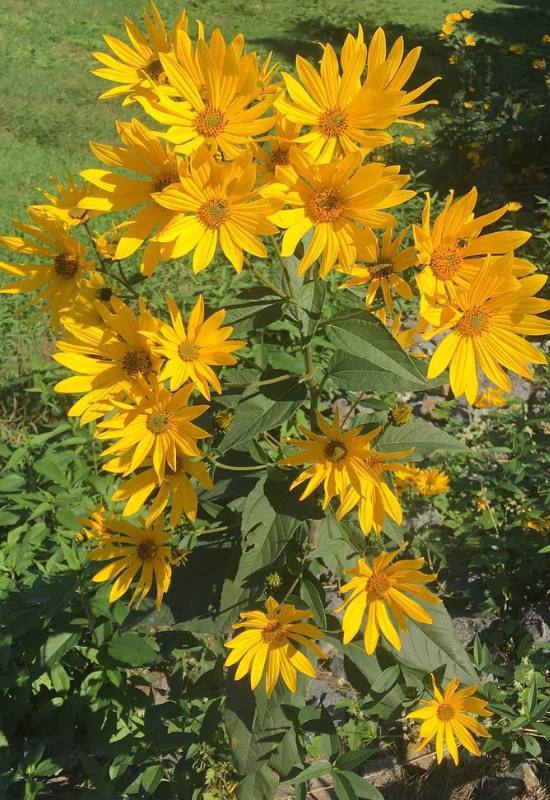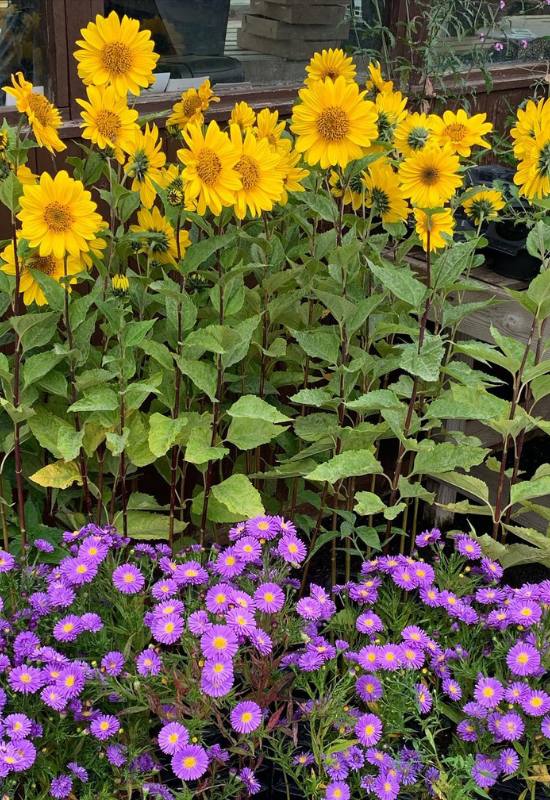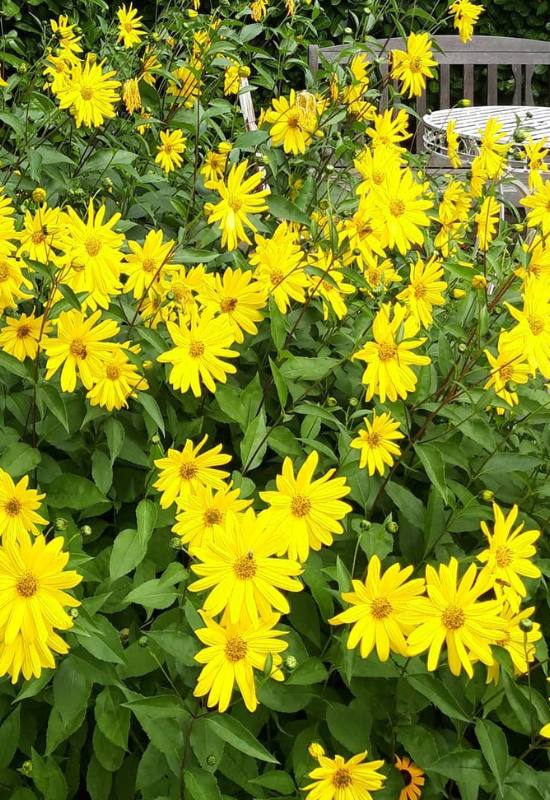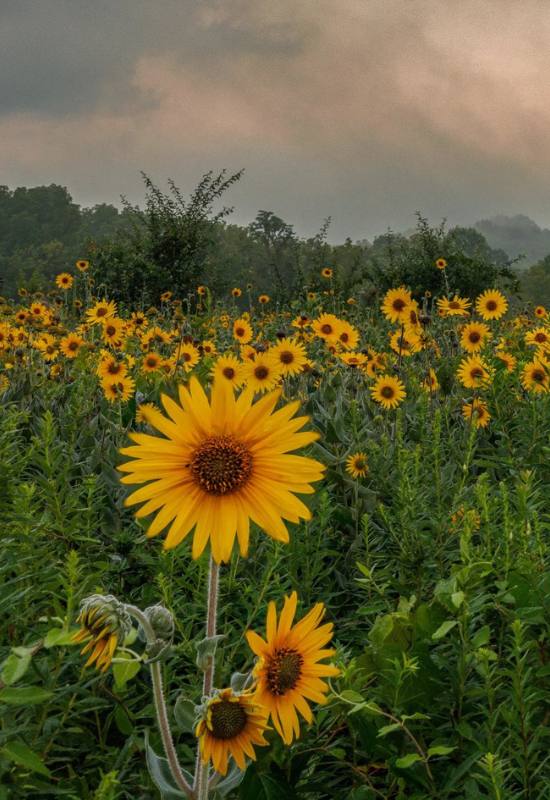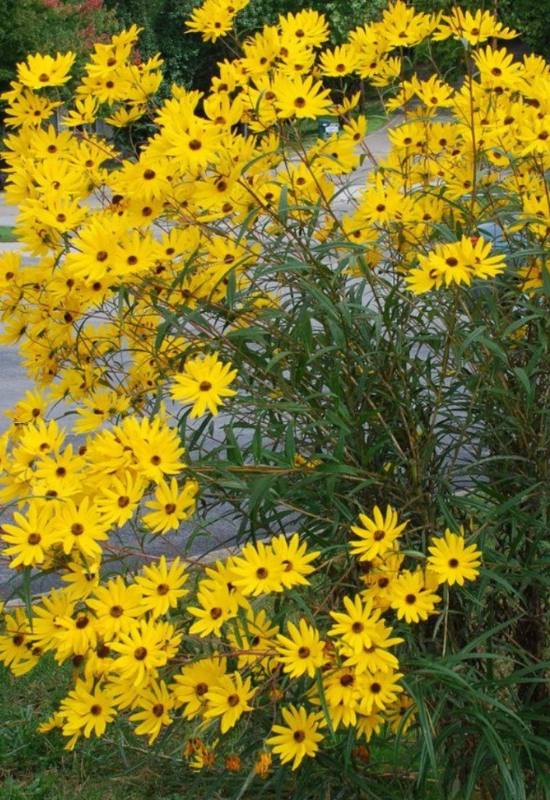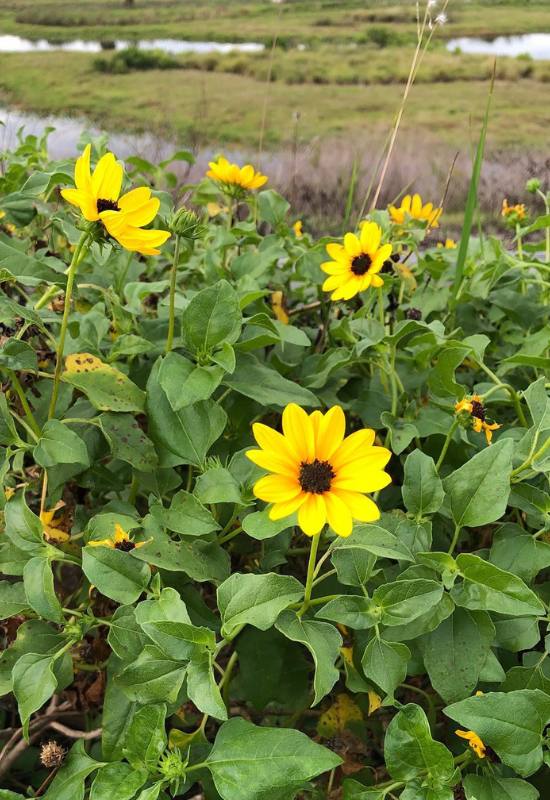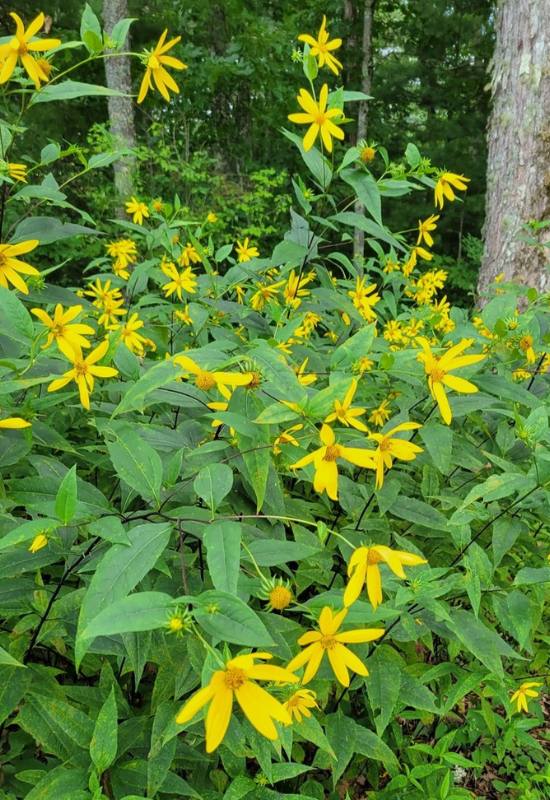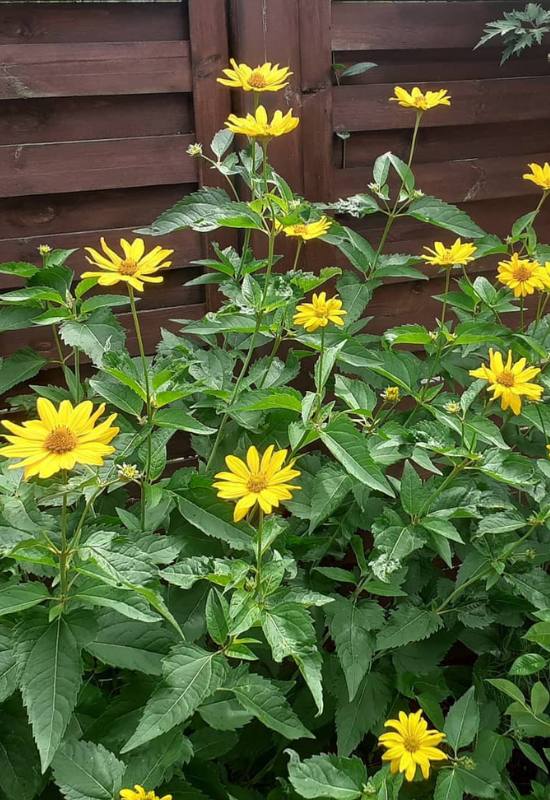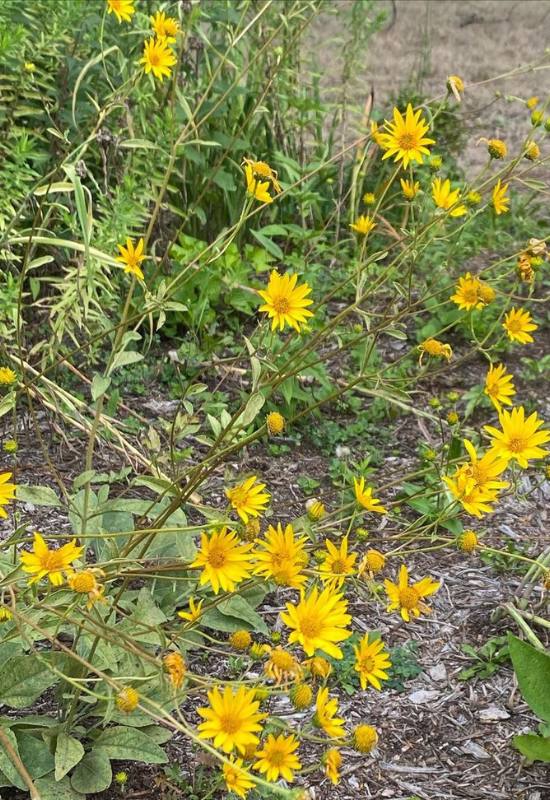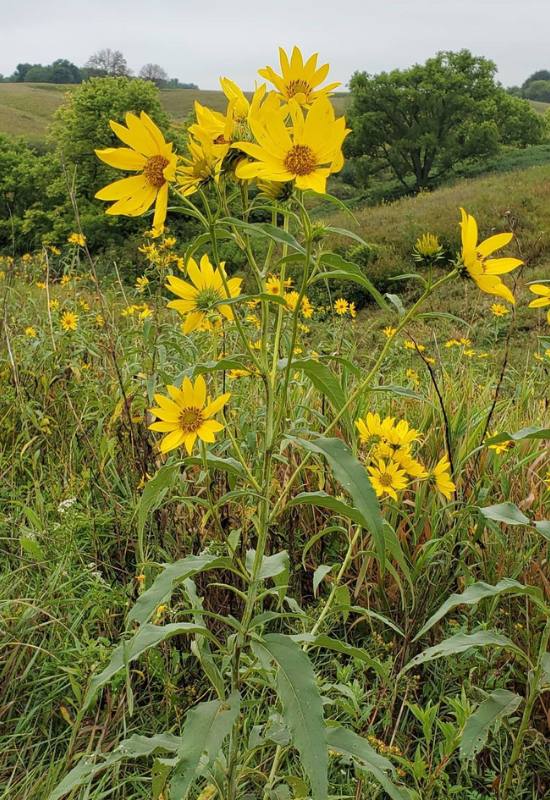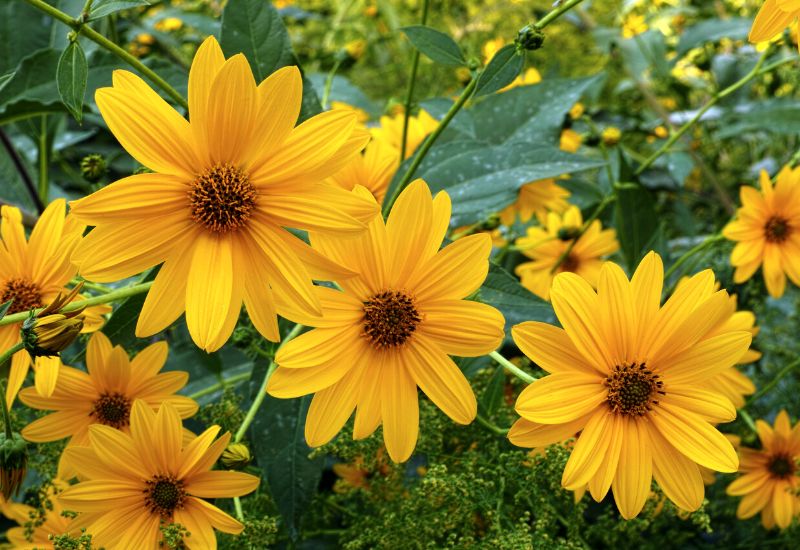
Sunflowers are famous for their large, energetic blooms that come in summer and keep bright till late fall, but they don’t come back after winter. Instead, there are quite a few perennial varieties that come back next spring, with new leaves and new blossoms!
In fact, the most common species is Helianthus annus, which is an annual, but others, like Jerusalem artichoke (Helianthus tuberosus) will return to fill your garden for three to five years before slowly diminishing.
Added bonus, perennial varieties of sunflowers have a tendency to spread quickly throughout the garden.
So, they are ideal for low maintenance naturalized areas where you want their energetic floral display but you cannot invest too much time and effort. Smaller species will also fit beds and borders and, for a final bonus… Some have edible and delicious tubers like precious topinambur!
Suitable for different purposes and growing conditions, we have selected the very best perennial sunflowers and we want to show them to you!
But we can start with a very important distinction: the difference between perennial sunflowers and the more common and better known annual varieties.
Is My Sunflower An Annual Or A Perennial?
Of the 70 species of the sunflower genus, Helianthus, only a handful are perennial, while the vast majority are annuals. If at first glance, and especially above ground they may look very similar, a keen eye will be able to tell you the difference.
And in fact, there are key traits, in behavior and morphology, that we use to tell them apart. Let’s learn how to identify if your sunflower is perennial or annual.
As you can see, there are many differences between annual and perennial sunflowers. And this has an impact on why you should pick one type or another.
Reasons to grow perennial sunflowers
So, the question is, why should you grow perennial varieties of sunflower? There are quite a few reasons, so, let’s see them.
1: Perennial Sunflowers Are Permanent
This is self evident; if you plant annuals, they will not last long, though they can self seed. Perennials will be part of your garden year after year, which means that you won’t need to replant your border or bed every spring.
2: They Attract Pollinators And Beneficial Insects
Perennial sunflowers attract lots of pollinators, and as you know, this is not just beautiful to see…
They also contribute to the health and fertility of your garden. In fact, they are also ideal in vegetable gardens, because large blooms of most perennial sunflowers attract beneficial insects like bees and butterflies, and especially bumble bees (by far the best pollinators in the world) from a distance, and they will also pollinate your tomatoes, peppers and cucumbers, and indeed all fruit vegetables and trees!
3: Make An Excellent Addition To Your Edible Garden
We all like sunflower seeds, and it’s true, you will get fewer with perennial varieties, but many species have edible tubers, the most famous being Jerusalem artichoke (Helianthus tuberosus) which is a real delicacy, and very expensive to boot!
Other varieties with edible tubers are Indian potato (Helianthus giganteus var. subtuberosus), Maximilian sunflower (Helinathus maximilianii) and cheerful sunflower (Helianthus x laetiflorus).
You don’t need to uproot the whole plant if you want to keep the flowers. You can take some of the tubers and leave others in the ground. In fact, it is also a god thinning method, because they are vigorous and grow into thick clumps very fast.
4: Big Displays with Low Maintenance with Perennial Sunflowers
All perennial sunflowers are easy to grow, can grow in wide range of soil conditions and they are very, very low maintenance. Many are even drought tolerant, some adapt to virtually barren and infertile soils, but they all have a massive energy and always produce huge floral displays.
For a cheap, reliable solution to even large areas if you do not have lots of time to spend, perennial sunflowers are a great choice for your low-maintenance garden!
5: Add Late Season Color To your Garden
Perennial varieties of Helianthus will blossom for very long periods, and sometimes they can start even in early summer. But most will continue with their energetic and bright flowers all the way to the end of the season, often stopping only with the first frost or the beginning of winter.
For this reason, when flowers start to become scarce, their vigorous and bright displays can brighten up your garden, with very little work on your behalf!
There are many other reasons, including the simple fact that they are easy to grow and beautiful. And to convince you of this, the best way is to look at them!
10 Types Perennial sunflowers That Comes Back To Bloom Every Year
Welcome to the final countdown of the very best perennial sunflower varieties. Here we come to the 10 perennial cultivars of Helianthus, better known as sunflower.
1: Jerusalem Artichoke (Helianthus tuberosus)
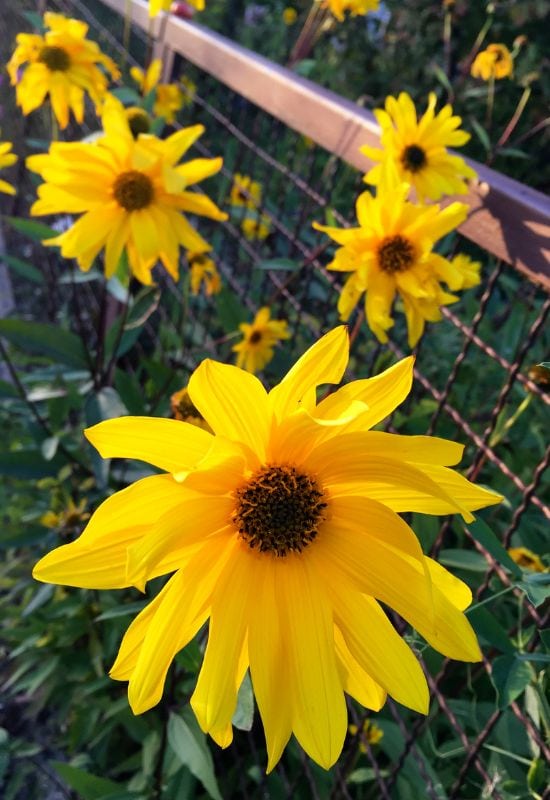
Certainly the most popular perennial sunflower is Jerusalem artichoke, or topinambur, at least when it comes to food and refined cuisine. The tubers are not just edible, but with their artichoke and hay flavor, amazing nutritional properties, they are a real delicacy.
And the flowers are very beautiful too. The petals, or ray flowers to be correct, are long yellow and with a lovely undulation lengthways.
They really look like the classical representation of our star, vibrant and full pf energy. Jerusalem Artichoke flowers will come in abundance at the tips of the stems, with small golden centers, or disks. They are smaller than most annual varieties, about 4 inches across (10 cm). The leaves spear head shaped, rough to the touch and green.
Great in tall borders, you can also grow Jerusalem artichoke in naturalized areas and of course, if you have a vegetable garden. You could even sell the tubers if you want, because it is very productive.
2: Ashy Sunflower (Helianthus mollis)
So called because its foliage is stiff and gray green, ashy sunflower is a perennial Helianthus variety with golden red ray petals, sometimes with a light orange blush as well. There are 15 to 30 in each head, or inflorescence, and they often form a round, full shape.
The central disk is darker in color, about 1 to 1.5 inches across (2.5 to 4.0 cm), while the whole bloom can reach 4 to 5 inches in diameter (10 to 12.5 cm). The blossoms will keep you company all through the summer months and into early fall, but from spring to frost it can add lush foliage to borders with its stiff leaves.
Ashy sunflower also has the vertical pull that we find in many annual varieties, with long upright stems, so, it is ideal also to add that vertical accent that many gardens need.
3: Swamp Sunflower (Helianthus angustifolius)
Swamp sunflower is the ideal perennial variety of sunflower to grow if your garden has wet soil, but it also tolerates dry conditions. The scientific name means narrow leaved, because the hairy foliage is indeed long, up to 6 inches (15 cm) and thin, unlike most other species.
The flowers are plentiful but small, only 2 to 3 inches across (5.0 to 7.5 cm), with 10 to 20 narrow and pointed yellow rays, which surround a small and purplish brown in color. It spreads fast, and it has many branches, which will bear the blossoms at the tips.
Swamp sunflower us a sturdy perennial variety, adaptable to very different conditions and blooming late in the season. It is ideal for an explosion of energy and color in a naturalized area, or in an area of your garden where you want a big effect but with little effort and time to spend.
4: Beach Sunflower (Helianthus debilis)
Beach sunflower is a heat loving perennial variety that stabilizes dunes, hence the name. Short and fast spreading thanks to its runners, it is ideal as groundcover also because it has evergreen foliage. The leaves are broad dark green, deltoid and irregularly lobed, about 4 inches long (10 cm) and quite dense.
The flowers are small, about 3 inches across (7.5 cm) with 10 to 20 vibrant but fairly dark yellow rays and a very dark purplish central disk. In most regions, it will blossom continuously from spring to fall, but in warm regions you may even expect some flowers during the winter season.
Beach sunflower is ideal for coastal regions and sandy soils; it will improve it and hold it, and it is a really hassle free perennial, perfect for wild and naturalized areas.
5: Woodland Sunflower (Helianthus divaricatus)
Most Helianthus varieties like very sunny places, but woodland sunflower is a perennial species that likes a bit of shade! This means that you can enjoy its bright yellow blooms, with 8 to 15, neatly spaced elliptical yellow rays even under trees. The name was a clue… The central disk is golden and very small.
The flowers are not big at all, about 2 inches across (5.0 cm) but they last for many months. On the other hand, the leaves are stiff, deep green and about 6 inches long (15 cm).
Woodland sunflower is a rhizomatous perennial variety, so it spreads fast and vigorously. For this reason, it is ideal for a naturalized woody area, where you want lots of blooms but with very low maintenance needs.
6: Ten Petaled Sunflower (Helianthus decapetalus)
Pretty cold hardy, ten petaled sunflower is a perennial variety with 8 to 12 ray petals. The name hits the math in the middle… Nevertheless, even if they are not many, the overall head looks quite full, and the dented tips give an extra touch to the strong yellow color of the rays, which are also undulated.
The central disk is reminiscent of coneflower (Echinacea) because it forms a golden dome. The serrated leaves are lance shaped, dark green, lush and glossy as well. It is also a shade loving species, quite uncommon in this genus.
Blooming all through summer and till the first frost, ten petaled sunflower is yet another perennial Helianthus variety which suits naturalized areas or large borders where you want to reduce the maintenance levels and save time!
7: Maximlian Sunflower (Helianthus maximilanii)
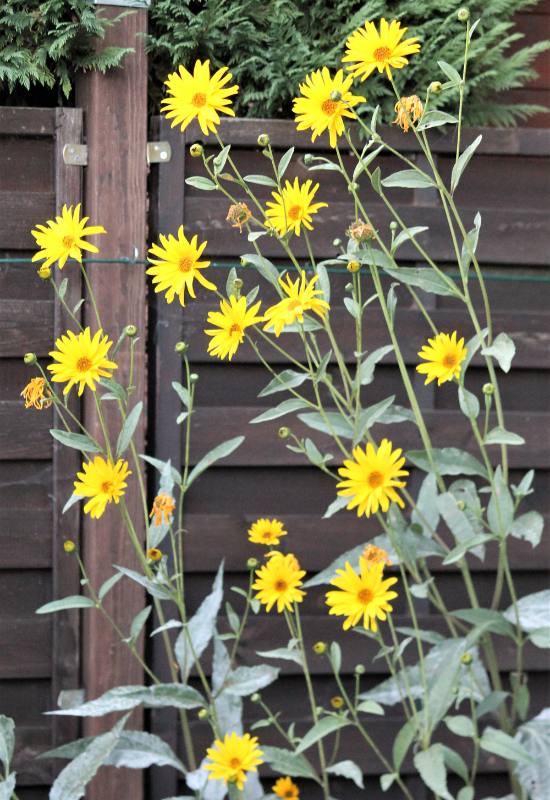
Maximilian sunflower is one of the perennial varieties of this genus with edible tubers. However, they are not as loved and popular as those of Jerusalem artichoke. The flowers usually have between 15 and 19 rays, and they are broad and pointed, with an elliptical shape.
Their color can be bright yellow or sometimes darker, almost approaching a pale orange shade. The disks are small and darker, and it will blossom very, very profusely for months on end. Tall and vertical in habit, it has dark grayish green leaves, elliptical in shape and rough to the touch.
Ideal for naturalized areas, Maximilian sunflower is not suitable to borders, because it needs lots of space to spread, and it does it very fast indeed!
8: Western Sunflower (Helianthus occidentalis)
Western sunflower is a perennial variety with showy blooms, about 2 inches across (5.0 cm) star shaped and with very regular rays, oval and elongated with a delicate pointed tip and relief lines that run along them.
These petals are golden yellow in color, and the disk is small, brownish with saffron anthers on display. The blossoms come on long upright stems that are almost bare, while lower down you will find a rosette of lush and dense basal leaves.
Perfect for a sunny border, reliable and very decorative, western sunflower is one of the most loved perennial varieties of Helianthus. It requires low maintenance and it is well behaved and, on top of this, it is useful against soil erosion.
9: Cheerful Sunflower (Helianthus x laetiflorus)
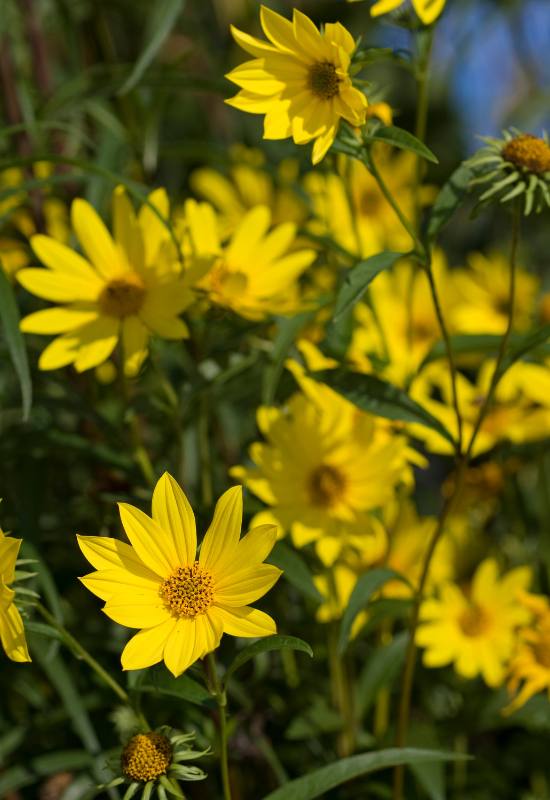
Cheerful sunflower is a very decorative perennial variety, with large blooms that reach 5 inches across (12.5 cm). The ray petals are arranged in a star shape, and they can vary in number and color, from a delicate Tuscan Sun yellow to bright golden and even bumblebee.
They will open on the ends of long stems, while the rich green leaves are large and lanceolate, with a rough surface and clear, deep veins that add to the texture of the foliage. This is one of the species with edible tubers, with a very strong flavor. And you can also chop up the leaves and cook them in omelets!
Ideal for both a vegetable and a decorative garden, cheerful sunflower is easy to grow and fast spreading, thanks. Thin it regularly by collecting the tubers from underground in spring and cooking them!
10: Sawtooth Sunflower (Helianthus grosseserratus)
The last perennial variety on our list is sawtooth sunflower, with showy blooms that reach about 4 inches in diameter, or 10 cm. The rays are well shaped, elliptical and pointed, golden yellow, like the central disk. They come on stems that branch out and hold many blossoms each, looking up to the sky.
Despite its name, the leaves are usually toothless, or sometimes they are serrated, yes, but only very lightly. But they are quite big, reaching 8 inches in length, or 20 cm! It is also one of the best varieties for cold climates, because it is very hardy.
Sawtooth sunflower is a late bloomer, so, it is suitable for an end of season energetic display in a naturalized area or wild flower garden.
Bright sunflowers year after year with perennials
Perennial sunflower varieties don’t have as massive blooms as annuals, nor do we have many colorful cultivars; but they are excellent for big displays with low maintenance and above all, they come back with their energetic blooms year after year.

Written By
Margie Fetchik
Margie and Arkansas native has an extensive background in gardening and landscaping. For the last 40 years, Margie has called the Colorado Rocky Mountains her home. Here she and her husband of 36 years raised three kids and owned a successful landscaping company. Margie has a CSU Master Gardener certification. She specialized in garden design & installation, perennial gardens, turf grasses & weeds, flower containers, and the overall maintenance of allHOA, commercial and residential accounts. She and her husband now reside in Denver and are excited about the new experiences’ city life holds.

